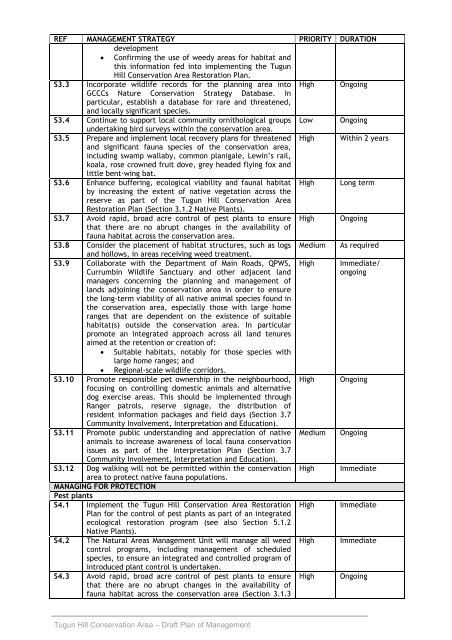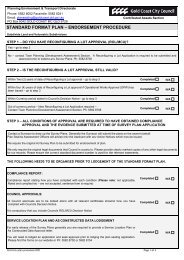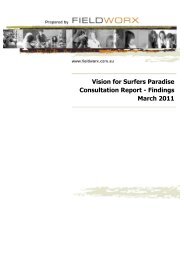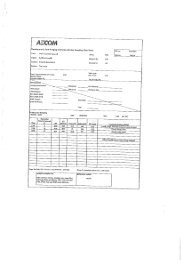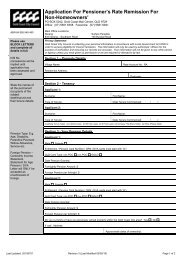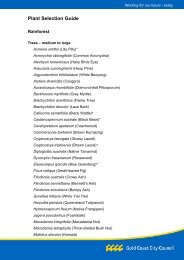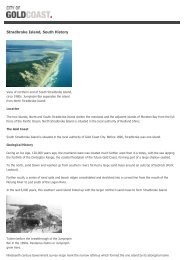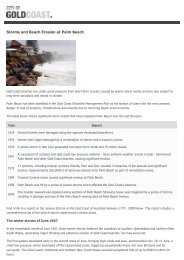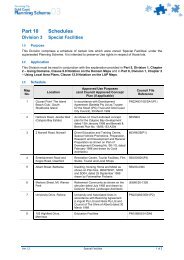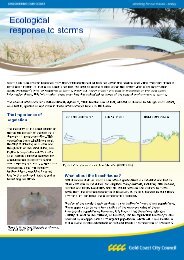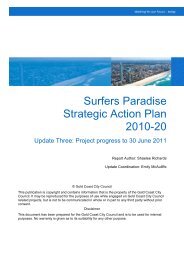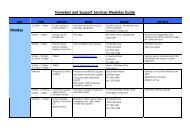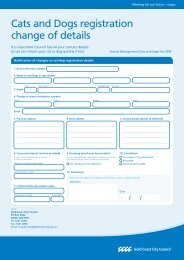Draft Tugun Hill Conservation Area Plan of Management
Draft Tugun Hill Conservation Area Plan of Management
Draft Tugun Hill Conservation Area Plan of Management
Create successful ePaper yourself
Turn your PDF publications into a flip-book with our unique Google optimized e-Paper software.
REF MANAGEMENT STRATEGY<br />
development<br />
PRIORITY DURATION<br />
• Confirming the use <strong>of</strong> weedy areas for habitat and<br />
this information fed into implementing the <strong>Tugun</strong><br />
<strong>Hill</strong> <strong>Conservation</strong> <strong>Area</strong> Restoration <strong>Plan</strong>.<br />
S3.3 Incorporate wildlife records for the planning area into High Ongoing<br />
GCCCs Nature <strong>Conservation</strong> Strategy Database. In<br />
S3.4<br />
particular, establish a database for rare and threatened,<br />
and locally significant species.<br />
Continue to support local community ornithological groups Low Ongoing<br />
undertaking bird surveys within the conservation area.<br />
S3.5 Prepare and implement local recovery plans for threatened<br />
and significant fauna species <strong>of</strong> the conservation area,<br />
including swamp wallaby, common planigale, Lewin’s rail,<br />
koala, rose crowned fruit dove, grey headed flying fox and<br />
little bent-wing bat.<br />
S3.6 Enhance buffering, ecological viability and faunal habitat<br />
by increasing the extent <strong>of</strong> native vegetation across the<br />
reserve as part <strong>of</strong> the <strong>Tugun</strong> <strong>Hill</strong> <strong>Conservation</strong> <strong>Area</strong><br />
Restoration <strong>Plan</strong> (Section 3.1.2 Native <strong>Plan</strong>ts).<br />
S3.7 Avoid rapid, broad acre control <strong>of</strong> pest plants to ensure<br />
that there are no abrupt changes in the availability <strong>of</strong><br />
fauna habitat across the conservation area.<br />
S3.8 Consider the placement <strong>of</strong> habitat structures, such as logs<br />
and hollows, in areas receiving weed treatment.<br />
S3.9 Collaborate with the Department <strong>of</strong> Main Roads, QPWS,<br />
Currumbin Wildlife Sanctuary and other adjacent land<br />
managers concerning the planning and management <strong>of</strong><br />
lands adjoining the conservation area in order to ensure<br />
the long-term viability <strong>of</strong> all native animal species found in<br />
the conservation area, especially those with large home<br />
ranges that are dependent on the existence <strong>of</strong> suitable<br />
habitat(s) outside the conservation area. In particular<br />
promote an integrated approach across all land tenures<br />
aimed at the retention or creation <strong>of</strong>:<br />
• Suitable habitats, notably for those species with<br />
large home ranges; and<br />
• Regional-scale wildlife corridors.<br />
S3.10 Promote responsible pet ownership in the neighbourhood,<br />
focusing on controlling domestic animals and alternative<br />
dog exercise areas. This should be implemented through<br />
Ranger patrols, reserve signage, the distribution <strong>of</strong><br />
resident information packages and field days (Section 3.7<br />
Community Involvement, Interpretation and Education).<br />
S3.11 Promote public understanding and appreciation <strong>of</strong> native<br />
animals to increase awareness <strong>of</strong> local fauna conservation<br />
issues as part <strong>of</strong> the Interpretation <strong>Plan</strong> (Section 3.7<br />
Community Involvement, Interpretation and Education).<br />
S3.12 Dog walking will not be permitted within the conservation<br />
area to protect native fauna populations.<br />
MANAGING FOR PROTECTION<br />
Pest plants<br />
S4.1 Implement the <strong>Tugun</strong> <strong>Hill</strong> <strong>Conservation</strong> <strong>Area</strong> Restoration<br />
<strong>Plan</strong> for the control <strong>of</strong> pest plants as part <strong>of</strong> an integrated<br />
ecological restoration program (see also Section 5.1.2<br />
Native <strong>Plan</strong>ts).<br />
S4.2 The Natural <strong>Area</strong>s <strong>Management</strong> Unit will manage all weed<br />
control programs, including management <strong>of</strong> scheduled<br />
species, to ensure an integrated and controlled program <strong>of</strong><br />
introduced plant control is undertaken.<br />
S4.3 Avoid rapid, broad acre control <strong>of</strong> pest plants to ensure<br />
that there are no abrupt changes in the availability <strong>of</strong><br />
fauna habitat across the conservation area (Section 3.1.3<br />
<strong>Tugun</strong> <strong>Hill</strong> <strong>Conservation</strong> <strong>Area</strong> – <strong>Draft</strong> <strong>Plan</strong> <strong>of</strong> <strong>Management</strong><br />
High Within 2 years<br />
High Long term<br />
High Ongoing<br />
Medium As required<br />
High Immediate/<br />
ongoing<br />
High Ongoing<br />
Medium Ongoing<br />
High Immediate<br />
High Immediate<br />
High Immediate<br />
High Ongoing


